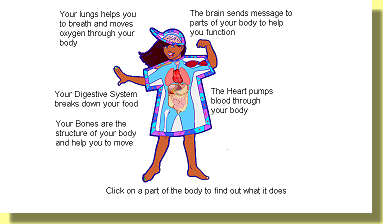FONTS
GDE
GOOGLE
HOME
LINKS
MAPS
MICROWORLDS
TD700-1
TD702
TIMETABLES
TJ501
TJ521
TJ591
TJ641
TJ828
TJ853
TUTORIALS
Home
> TK 423 Written Critique - MicroWorlds Team Project
TK 423 Written Critique - MicroWorlds Team Project
Links
An Examination of the Impact of Aspects of Online Education Delivery on Students
Marinka Dunlop, Commerce & Management, Southern Cross University,Mdunlop@scu.edu.au
Don Scott, Commerce & Management, Southern Cross University,Dscott@scu.edu.au
http://ausweb.scu.edu.au/aw01/papers/refereed/dunlop/paper.html
Hendricks, J. A. (2004, January 20). The Netgeneration: The Internet as classroom
and community. Current Issues in Education [On-line], 7(1). Available: http://cie.ed.asu.edu/volume7/number1/
e-learning communities
This area describes the unique characteristics of online cultures and strategies
used to foster effective e-learning communities with implications for the professional
preparation and ongoing development of teachers.
http://www.pt3.org/VQ/e_learn.php3
e- Learning: Ethics and Governance Considerations
John P. Witherspoon
Western Cooperative for Educational Telecommunications
http://www.pt3.org/VQ/html/witherspoon.html
Mentis, M., Ryba, K., & Annan, J. (2002). Creating authentic on-line communities
of professional practice. E-JIST: E-Journal of Instructional Science and Technology
[Online], 5(2), Available: http://www.usq.edu.au/electpub/e-jist/docs/html2002/pdf/mentis.pdf.
Local Copy
http://www.doaj.org/abstract?id=93950&toc=y
DOAJ - Directory of Open Access Journals, 2005
http://www.doaj.org/openurl?genre=journal&issn=13240781&volume=5&issue=1&date=2001
Mentis, M, Ryba, K & Annan, J (2002). Creating authentic online communities
of professional practice. E-Journal of Instructional Science and Technology,
5, 1, 1-15.
http://www.usq.edu.au/electpub/e-jist/docs/html2002/mentis_frame.html
http://vcsymposium.massey.ac.nz/presenters/krmm.htm
WebCT 2002 Annual Conference.
http://www.webct.com/2002
http://booboo.webct.com/2002/papers/mentis.pdf
http://www.crimeinstitute.ac.za/2ndconf/papers/de_laat.pdf
Sustainable
Learning Communities - Links
http://www.inknowvate.com/NaturalBridges/sustainable_learning_communities_links.htm
http://pages.britishlibrary.net/blwww3/education/online.htm
http://www.flexiblelearning.net.au/nw2002/extras/commsonline.pdf
|
Dear Natalie,
I have been sick for the past week and as such have not put as much work
into this critique as I would like.
If you feel that it is not adequate please let me know and I will happily
add to it.
Rupert.
|
Contents:
Title
Abstract
Introduction
Development of evaluative framework
Critical Reflections
Implications for future action
Appendices
References
Title
Title: Written Critique - MicroWorlds team project
Author: Rupert Russell
Student Number: 941510
Due: Friday August 20, 2004
Date Submitted: August 20, 2004 8:00 pm
Contents
Abstract
The project is designed to enable students to work cooperatively in small
groups on the development, implementation & testing of a simple teaching
application developed using MicroWorlds
a multimedia LOGO
application.
The design of the project focuses on the following principles of teaching
for quality learning:
- sharing intellectual control with students;
- allowing students to work out solutions to problems;
- providing an opportunity for choice and independent decision-making;
- promoting exploratory talk;
- encouraging students to learn for other students';
- promoting assessment as part of the learning process.
Contents
Introduction
Learning and teaching context:
The preservice teachers (PST's) undertalking the project are 4th year undergraduate
Bachelor of Education students enrolled in a 10 credit point Information
and Communication Technology (ICT) elective. These students will graduate
in 2005 as primary school teachers. Some may choose to work as specialist
ICT teachers, most will become generalist teachers.
The PST's are a mix of mature aged and mainstream 4th year students. They
have all completed a prior ICT curriculum unit and have elected to undertake
an additional ICT unit. This is an indication of their interest in using
ICT in their teaching and learning.
They are all expected to have basic ICT skills as a result of their prior
study. They may have undertaken additional ICT electives with the school
of Information Technology & Mathematical Sciences (ITMS). Most come
from an Anglo-Saxon middle class background. All speak English as their
first language. None have any physical or intellectual handicaps that would
impact on their participating in this teamwork project.
Learning objectives:
- The ability to devise and develop a simple teaching & learning application
using MicroWorlds.
- The ability to identify learning outcomes that lend themselves to the
use of simple computer applications.
- Increased familiarity MicroWorlds & LOGO
- Increased sense of self effectives
Learning design issues:
I believe that it is important to provide students with the ability to
work independently of the tutor. This promotes a sense of independence and
encourages students to develop the attitudes and skills necessary to promote
lifelong and life-wide learning (Candy 20??) . To support students working
on their projects independently I provided them with a
fully functional demonstration copy of MicroWorlds which they can install
and use on their home computers for 15 days, as well as a limited
function trial version that will run indefinitely. This will be adequate
time to allow them to complete the MicroWorlds assignment. I provided these
versions on CD-ROM to allow ease of installation. I have also provided each
group with a printed copy of the
MicroWorlds user manual, and each student with a set of my
own MicroWorlds Notes teaching notes, and a copy of the MicroWorlds
quick start notes. I have also provided a number of online examples.
See Appendix 3 For a list of the MicroWorlds
Teaching Notes, Examples & Links that I provided.
Contents
Development of evaluative framework
4-6 key learning and teaching principles that you think underpin effective
design of student-centered, flexible learning experiences.
Learning + Enjoyment = Retention
Richard Howell Allen (2002) highlights the importance
of enjoyment in retaining information. If students do not enjoy what they
are doing then they may choose to "actively seek to forget" the
lesson in order to avoid having the unpleasant experience brought back into
their consciousness. It is my intent when planning this project that student
should enjoy creating their applications and that they will want to demonstrate
their creations to their friends and peers. The peer assessment component
of this project allows for sharing of work between each group and allows
each group to take pride in their creations.
Application is Everything
In choosing this project I have attempted to make the connection between
the design of each individual groups applications and the way that this
application could be used within a classroom explicit. By requiring each
group to identify a learning outcome and then develop an application to
assist in teaching this concept I have placed the responsibility for making
the connection between MicroWorlds applications and teaching & learning
with each group. I hope that on completion of this project that each student
will have a clear idea of some of the ways in which MicroWorlds can be used
by them and their students in future lessons. During my teaching I attempt
to make explicit connections between the ideas, concepts, and techniques
that I am teaching and ways in which my students can utilise these ideas
& techniques in their own teaching. Without making these connections
the ideas and skills I am teaching may quickly fade from memory. (Allen,
2002)
Collaboration Enhances Learning
"a learner self-assesses the success of a project
frequently and incrementally by testing procedures. A learner gauges the
ultimate success of a project by sharing it with others and noting their
interactions and reactions."
Contents
Critical Reflections
The project design allowed the PST's to develop a diverse set of teaching
applications. I enjoyed watching the groups exploring ideas and working corroboratively
to produce a finished product.
An essential aspect of this project design was the ability for each group
to develop their own individual products. The first task for each group was
to determine a Key learning Area (KLA) CSF II level and learning outcome suitable
for basing the design of their teaching and learning application on.
In order to facilitate their understanding a possible way to connect a learning
outcome with a finished application I demonstrated a simple MicroWorlds application
that I had created and provided them with a copy of the application on my
website for them to download and use. See Table 1. Example
Teaching & Learning application 1. On reflection providing an example
addressing only one KLA maths was a shortcoming in the end 2 of the 3 groups
decided on addressing a maths outcome, one group chose to produce an application
that was very similar to the example I provided.
Providing a boarder range of examples addressing a range of KLA's would most
likely have produced a wider range of finished products. This is supported
by the fact that the only group that produced an application that was addressing
a KLA other than maths was the group that I demonstrated a second MicroWorlds
application created by a pair of students in 2002 that related to the KLA
Heath. See Table 2. Example Teaching & Learning application
2.
It may be that imposing a restriction preventing more than one group from
addressing the same KLA may have ensured grater diversity in the range of
application that were produced. This is similar to the Franklin's (2001) notion
of "The professor as censor" where Franklin demonstrates that the
diversity of student video productions is increased when the professor prevents
students from conforming to common themes. While Franklin's (2001) work is
limited to Digital Video Production I see no reason why similar benefits could
not be obtained in many other fields.
After close reflection on the process I employed it has become apparent to
me that although there were some benefits from the group tasks I do not believe
that the students achieved the learning outcomes and changes in attitude that
I had hoped that they would. I now believe that a much more sustained contact
with the MicroWorlds application would be required to lead to a substantial
increase in their sense of self effectiveness I also recognise now that the
model of teaching that I employed was flawed. In attempting to ensure that
each group produces a working product by the end of the second session I ended
up adopting a poor teaching practice. When each group ran into a problem with
there application they would simply stop and wait for me to debug the problem
for them so that they could continue with their development. Although this
approach was expedient in that it allowed for faster development than would
be the case if I had not provided this support I now believe that this approach
did little to allow group members to increase their confidence with using
the MicroWorlds application.
Contents
Implications for future action
This was the first time that I have implemented a group work project based
on MicroWorlds. The results both in terms of the process and products were
rewarding for both the students and myself to observe. I intend to build on
this initial experience in future years. One way that I will be able to do
this is to use a wider range of demonstration applications, including examples
that I create and the projects created by the three groups this year. See
appendix 4.
After reflecting on the shortcommings of the pedagogy that I adopted in attempting
to ensure that each group produced a finished product within only 2-3 hours
of development work if I were to implement this type of project in the future
I would ensure that I allowed much more time for each group to explore the
MicroWorlds environment and I would place less importance on production of
a finished product within a short time frame. I now recognise that it takes
a significant amount of time for students to gain a sense of security and
confidence in their ability to program in MicroWorlds LOGO.
Contents
Appendices
Appendix1
Instuctions for the MicroWorlds Group Project
Note: don't forget the KISS principle (Keep It Simple Stupid). Do not get
caught up with creeping
featurism. This is when programmers keep adding more and more features
to a program often loosing sight of the original purpose, or simply overwhelming
the user with choice.
Your task with this group project is to produce a
simple application that assists with teaching one learning outcome
from any CSF
II Level
& KLA.
So pick something easy to implement and don't spend more than a day developing
the application outside of tute time. Time will be available in the tutorial
sessions for developing, debugging & testing applications. Use other groups
as usability testers. The best way to find out if a program works or not is
to simply ask someone to use it. Give them the absolute minimum instructions
and watch what they do. Usually they will find ways of breaking it that you
had never dreamed of...
See my example produced for CSF II level 1 maths learners. Note this program
would be used by a teacher working either one-to-one or in small groups when
discussing terms such as. Above, Below, Left, Right, In Front, Behind, as
well as naming simple shapes & colours.
Appendix 2 Example Teaching & Learning Application 1.
| 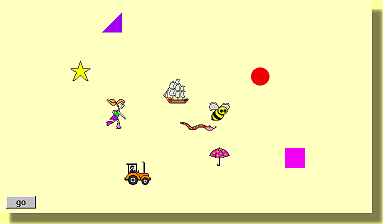
maths1.zip 20KB  use winzip to unzip
use winzip to unzip
to go
;-------- This procedure sets the shape of each turtle
; to a random shape. It then moves each turtle
; to a random position on the screen making sure
; that each turtle is not too close to the side
; of the screen.
;
; It then changes the shape of the turtle "t_star
; back to a star. This way there will always be
; a single star on the screen.
cg
everyone [pu]
everyone [setsh (random 62) + 1]
everyone [setx (random 335) - (random 335)+ 5]
everyone [sety (random 176) - (random 176)+ 5]
talkto "t_star
setsh "star
end |
Table 1. Example Teaching & Learning Application 1.
Appendix 3 Example Teaching & Learning Application 2.
Table 2. Example Teaching & Learning Application 2.
See: Details of Workshop
activities for full details of the Group Project
Appendix 3 MicroWorlds Teaching Notes, Examples & Links:
Introduction to Turtle
Graphics
My Microworlds
Logo Notes
The Official
MicroWorlds user manual
Example
LCSI MicroWorlds Projects
MicroWorlds Logo Links
& Examples
Appendix 4 2004 Student Projects
Group 1 - The Butterfly Life Cycle
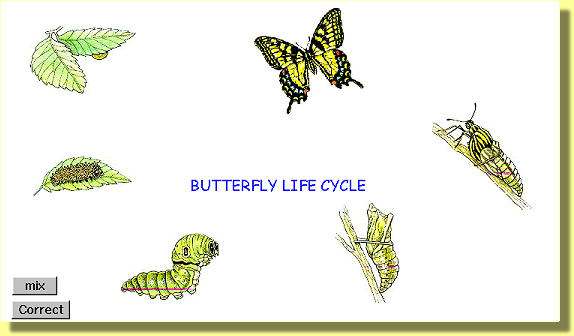
The Butterfly Life Cycle - 75% scale reduction.
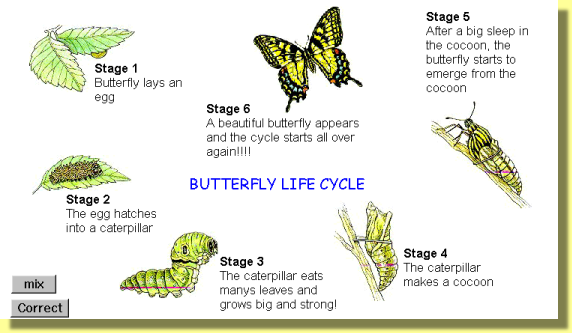
The Butterfly Life Cycle - Showing all text
boxes - 75% scale reduction.
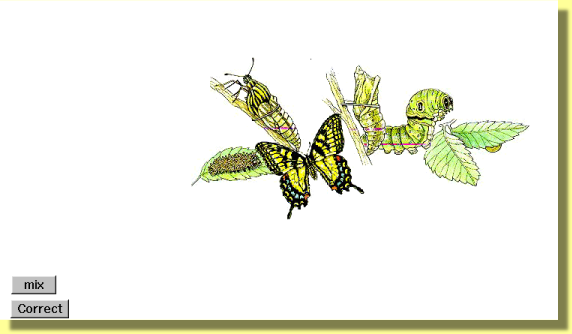
The Butterfly Life Cycle - Mixed - 75% scale reduction.
|
Table 3. Group 1 Student Project - The Butterfly Life Cycle
Group 2 - Ordering Corners
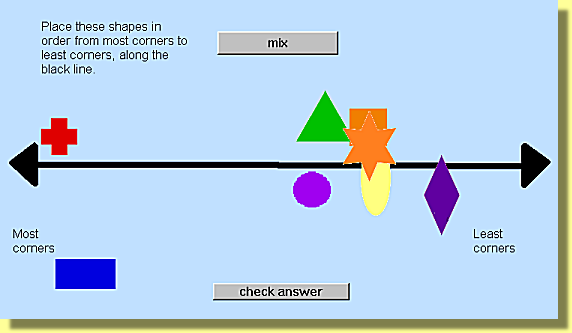
Shapes - Mixed - 75% scale reduction.
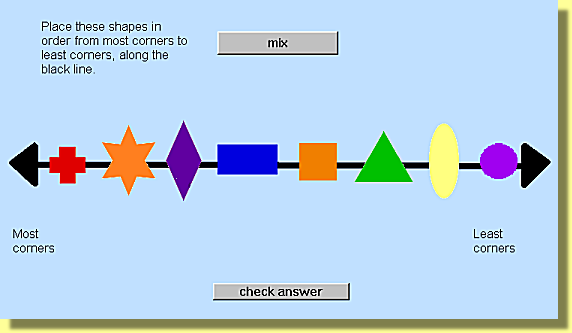
Shapes - Checked - 75% scale reduction. |
Table 4. Group 2 Student Project
Group 3 - Ordering Size
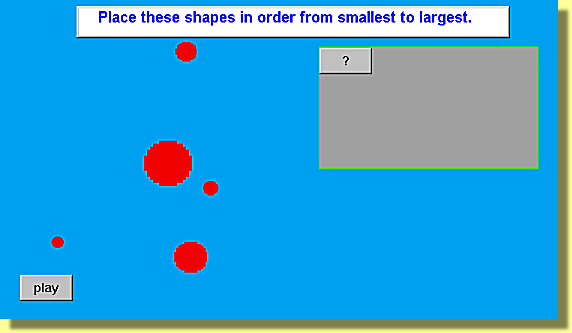
Ordering Size - 75% scale reduction.
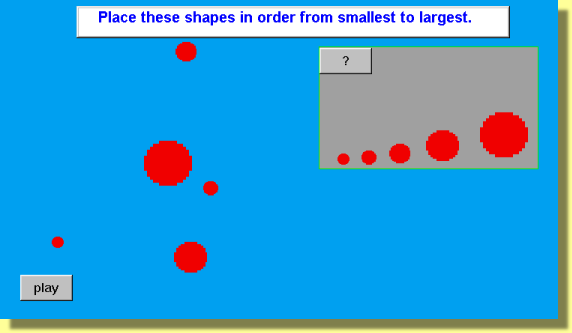
Ordering Size - Checked - 75% scale reduction.
|
Table 5. Group 3 Student Project
Group 4 - Maths Sentence
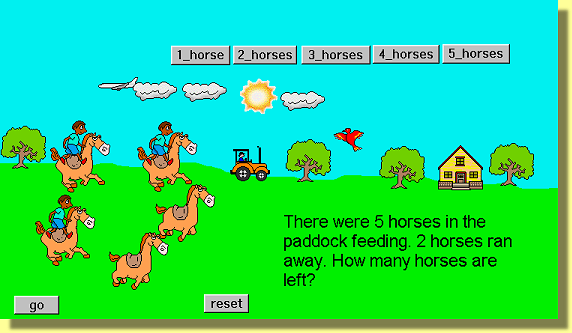
Maths Sentence - Reset - 75% scale reduction.
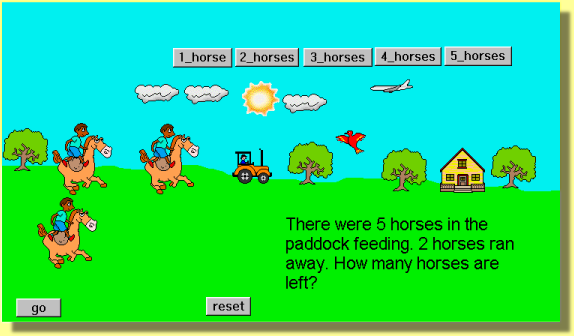
Maths Sentence - After animation - 75% scale reduction.
|
Table 6. Group 4 Student Project
References
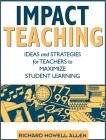
Allen, R.H. (2002). Impact teaching: Ideas and strategies for teachers
to
maximize student learning. Boston: Allyn
& Bacon.
Check availability at the Mt
Helen Library
Principles of teaching for quality learning (August 18, 2002).
retrieved July 22, 2004, from the PEEL, Project
for Enhancing Effective Learning website
http://www.peelweb.org/principles.html
Papert, S. (2000) What's the big idea? Toward a pedagogy of idea power.
IBM Systems Journal, 39 (3&4)
720-729 retrieved August 2, 2004, from the
IBM Research website http://www.research.ibm.com/journal/sj/393/part2/papert.pdf
Franklin, D. (2001) The professor as censor: Creative limitation and film
production pedagogy. Journal of Film &
Video, 53(1), 25-39.
Gardner, H. (1993) Multiple intelligences: The theory in practice –
a reader. New York: Basic Books.
Gokhale, A. (1995) Collaborative learning enhances critical thinking. Journal
of Technology Education, 7(1). Retrieved
August 6, 2004, from http://scholar.lib.vt.edu/ejournals/JTE/jte-v7n1/gokhale.jte-v7n1.html
Mahenthiran, S. and Rouse, P.J. (2000). The impact of group selection on
student performance and satisfaction. The
International Journal of Educational Management,
14(6), 255-265.
Resnick, Mitchel, "Rethinking Learning in the Digital Age," Chapter
3 in The
Global Information Technology Report 2001-2002: Readiness
for the
Networked World
http://www.cid.harvard.edu/cr/pdf/gitrr2002_ch03.pdf
Contents
APA
Citation:
Russell, R. (2004, August 20). TK 423 written critique - Microworlds team
project
Retrieved [insert month day, year], from
http://www.rupert.id.au/TK423/critique.html

|

